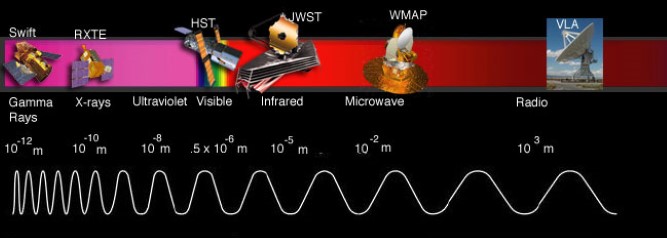As of 2014, the only UV spectrographs currently operating above the Earth’s atmosphere for observing faint celestial objects are STIS and COS on the HST. HST was launched in 1990, but it’s actually seven years older. Originally, it was prepared for a 1983 launch, which slipped to 1986 and then to 1990 after the 1986 failure of the Challenger space shuttle. The HST has had a long and successful life because it was designed to be serviceable by astronauts working aboard the space shuttle. However, the last servicing mission occurred in 2009 and the NASA space shuttles have been moved to museums.
We all hope that the HST will continue to operate to 2018, or even beyond 2020. In 2018 a replacement for the HST, the James Webb Space Telescope (JWST), a 6.5-meter reflecting telescope optimized to observe at infrared wavelengths, is expected to be launched. However, the JWST will have no UV instruments.
James Webb Space Telescope's Spectral Range: JWST will have four instruments that work primarily in the infrared area of the spectrum, with some coverage in the red areas of the visible spectrum.
Credit: NASA
One could imagine producing a much more capable version of the HST for visible light imaging and for continued exploration of the UV region of the spectrum. Unfortunately, such a mission might cost more than the JWST, which is estimated to be $8 billion by the expected launch date. We are not likely to see the visible light and UV equivalent of the JWST for several decades or more. In the mean time, UV space astronomy could be pursued with highly targeted moderate and small missions like the highly successful modest size GALEX UV imaging mission. For this to happen NASA and/or the European Space Agency (ESA) would need to allow for a more balanced mixture of mission opportunities from small to medium to large. Fortunately, the previous UV missions have created a huge archive of observations that astronomers will continue to mine for many years after the HST ceases to operate. However, the future vitality of UV astrophysics does require new satellite launch opportunities. A major effort aimed at reducing the construction and operation costs of space observatories will be required to keep the different windows on the Universe open.


